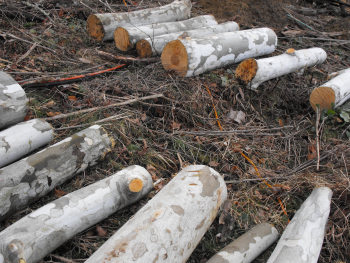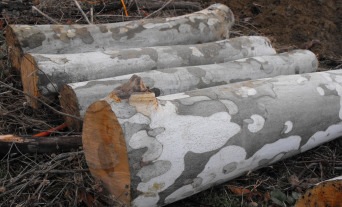
Preparing for your mushrooms --- cutting logs
 We took advantage of a beautiful day on Monday
to cut down our mushroom trees. Logs for
mushrooms should be cut from healthy living trees so that your spawn
doesn't have any wild fungi to compete with, and February is the
perfect time of year to cut the fully dormant trees.
We took advantage of a beautiful day on Monday
to cut down our mushroom trees. Logs for
mushrooms should be cut from healthy living trees so that your spawn
doesn't have any wild fungi to compete with, and February is the
perfect time of year to cut the fully dormant trees.
The type of tree to cut for your mushroom depends on the species you
want to grow. Shiitakes can be grown on oaks,
Sugar Maple,
Ironwood, Sweetgum, and a few other species --- most people prefer to
grow them on oaks. However, we don't have many oaks in our forest
since they're a prime timber tree, so I was glad to learn that a study
in North Carolina suggested that Sycamore is an even better host for
shiitakes in our area.
Oyster mushrooms can grow on just about any hardwood but they
prefer
the softer ones which shiitakes don't like. I was thrilled to
learn that oysters thrive on Box-Elder --- since our floodplain is
about 50% Box-Elder, that will be our tree of choice for the oyster
mushrooms. (Unlike shiitakes, oyster mushrooms are actually
native to our area and can be found wild in our woods, but I don't
trust my skills enough to eat wild mushrooms. While checking this
out, I also learned that oyster mushrooms kill and eat nematodes ---
who would have known!)
 If you cut your trees earlier
in the winter, you should leave them
whole until near the time for innoculation. But since we will be
innoculating soon, we went ahead and cut our trees up into logs ---
about 3 to 8" inches in diameter by 36 to 40 inches long. I've
found that shorter and thinner logs are a bit easier to manhandle into and out of
the kiddy pool we soak them in. Stay tuned for innoculation!
If you cut your trees earlier
in the winter, you should leave them
whole until near the time for innoculation. But since we will be
innoculating soon, we went ahead and cut our trees up into logs ---
about 3 to 8" inches in diameter by 36 to 40 inches long. I've
found that shorter and thinner logs are a bit easier to manhandle into and out of
the kiddy pool we soak them in. Stay tuned for innoculation!
| This post is part of our Innoculating Mushroom Logs series.
Read all of the entries: |
Want more in-depth information? Browse through our books.
Or explore more posts by date or by subject.
About us: Anna Hess and Mark Hamilton spent over a decade living self-sufficiently in the mountains of Virginia before moving north to start over from scratch in the foothills of Ohio. They've experimented with permaculture, no-till gardening, trailersteading, home-based microbusinesses and much more, writing about their adventures in both blogs and books.
Want to be notified when new comments are posted on this page? Click on the RSS button after you add a comment to subscribe to the comment feed, or simply check the box beside "email replies to me" while writing your comment.
